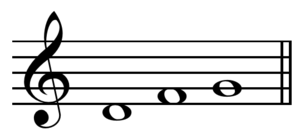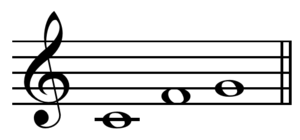Bayati (maqam)


Bayātī (Arabic بياتي), AKA Bayat and Uşşâk (Ushaq), is the name of a maqam (musical mode) in Arabic, Turkish, and related systems of music. Some Islamic people are known by the name Bayati. It is also used as a 'name of home'. Bayati is similar to a natural minor scale, with the primary exception of a half-flat second degree. The dominant of the scale is on the fourth degree.
The maqam is immensely popular in the Arab world, particularly in the Levant. In secular settings, it is favored in dabke and pop music.
Bayati is also used very often in religious liturgies of the Middle East. It is the favored maqam of use for the adhan in Medina, Saudi Arabia. Syrian Jews have an abundance of pizmonim in this maqam, and usually apply it to all Bar Mitzvahs and to Saturday Night services. According to the Assyrian Church of the East, this mode is called Qadmoyo (first).
Related maqamat are Husseini and Bayati Shuri.
Nucleus
The central tones of a maqam are created from two different intervals. The eleven central tones of the maqam used in the phase sequence example above may be reduced to three which make up the "nucleus" of the maqam:
The tone rows of maqamat may be identical, such as maqam bayati and maqam 'ushshaq turki:
but be distinguished by different nuclei. Bayati is shown in the example above, while 'ushshaq turki is:
- Maqam Bayat on La: La / Si (Half-flat) / Do / Re / Mi / Fa / Sol / La.
- Maqam Bayat Si: Si / Do (Half-Sharp) / Re / Mi / Fa sharp / Sol / La / Si.
- Maqam Bayat Do: DO / Re (Half-flat) / Mi flat / Fa / Sol / La flat / Si flat / Do.
- Maqam Bayat Re: Re / Mi (Half-Flat) / fa / Sol / La / Si Flat / Do / Re.
- Maqam Bayat Mi: Mi / Fa (half-Sharp) / Sol / la / Si / Do / Re / Mi.
- Maqam Bayat Fa: Fa / Sol (half-flat) / La flat / Si flat / Do / Re flat / Mi flat / Fa.
- Maqam Bayat Sol: Sol / La (Half-flat) / Si Flat / Do / Re / Mi flat / Fa / Sol.
- Maqam Bayat Si Flat: Si Flat / Do (Half-Flat) / Re flat / Mi flat / Fa / / Fa Sharp / La flat / Si flat.
- Maqam Bayat Do Sharp: Do Sharp / Re (Half-Sharp) / Mi / Fa Sharp / La flat / La / Si / Do sharp.
- Maqam Bayat Mi Flat: Mi flat / Fa (Half-flat) / Fa Sharp / La flat / Si flat / Si / Do flat / Re flat.
- Maqam Bayat Fa Sharp: Fa Sharp / Sol (Half-Sharp) / La / Si / Do Sharp / Re / Mi / Fa Sharp.
- Maqam Bayat Sol Sharp: Sol Sharp / La (Half-Sharp) / Si / Do Sharp / Re Flat / Mi / Fa Sharp / Sol Sharp.
(H-F) is Half-Flat (keep in mind that flat lowers the note half step down, Half flat means the note is lowered 1/4 step down). (H-S) is Half-Sharp (Sharp raises the note half step up, half sharp raises it 1/4 step up)
References
- ^ Touma, Habib Hassan (1996). The Music of the Arabs, p.42. Trans. Laurie Schwartz. Portland, Oregon: Amadeus Press. ISBN 0-931340-88-8.
External links
- Bayati page from Maqam World



